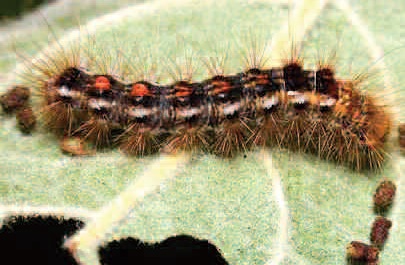Browntail caterpillar eating up countryside
by Roland D. Hallee
It’s amazing how one day you are oblivious of certain things, and the next day. you learn how a small, previously obscure caterpillar is now raping the landscape along the southern Maine coastline, and moving swiftly into the central part of the state.
The browntail moth caterpillar falls into that category. It not only poses a health problem for trees and insects, but it can also make humans uncomfortable.

browntail moth caterpillar
Last fall, Maine Forest Service entomologist Charlene Donahue wanted to see just how much damage browntail moth caterpillars were causing by chomping on the leaves of hardwood trees and shrubs. So, she did an aerial survey.
“In September, when the little teenie weenie caterpillars that are about a twelfth of an inch long were feeding, and mapped over 11,000 acres of feeding damage,” she says.
That means when they mature, and reach a size of about two inches in length, they are going on a mission to defoliate everything in sight. Donahue says most browntail moths are centered in the Topsham, Brunswick and Bowdoinham areas of the state, but the infestation has expanded. It has now been reported in the central Maine area from Waterville-Winslow to Lewiston-Auburn and even further south to Kittery.
And while that’s bad news for trees like oaks and apples, it’s also bad news for people because the caterpillars shed hair that can cause poison ivy-like rashes and breathing problems if ingested.
“The hairs can last for a year or 2-3 years, so people — even if the browntail moth go away — they go and rake or work in the brush in a place that’s been infested in the past, you can still end up with a rash,” Donahue says.
The severity of this year’s infestation is prompting the town of Cumberland to consider spraying pesticide in an area of town most affected, Cumberland Foreside.
Apparently, this is something that happens every year and the Cumberland Town Council tries to be pro-active.
According to Council chairman Peter Bingham, “Cumberland has considered spraying in the past, but abandoned the plan after too many homeowners opted out. The town held a workshop recently to help determine whether to spray this time around.”
Donahue says using pesticides would provide relief for people in the area, but it won’t get rid of browntail moth entirely. They’re invasive, from Europe, and don’t have natural predators.
According to biologists, the caterpillar and moth have been around these parts for well over 100 years. See what I meant when I said it all of a sudden makes news.
The only thing that seems to slow down browntail moths is a fungal disease, which hasn’t been as prevalent in recent years.
Donahue says to avoid exposure, mow the lawn when it’s wet. Don’t hang laundry outside where it can pick up the caterpillar’s hairs. And wear long sleeves and pants if you’re in an infested area.
Responsible journalism is hard work!
It is also expensive!
If you enjoy reading The Town Line and the good news we bring you each week, would you consider a donation to help us continue the work we’re doing?
The Town Line is a 501(c)(3) nonprofit private foundation, and all donations are tax deductible under the Internal Revenue Service code.
To help, please visit our online donation page or mail a check payable to The Town Line, PO Box 89, South China, ME 04358. Your contribution is appreciated!


Leave a Reply
Want to join the discussion?Feel free to contribute!